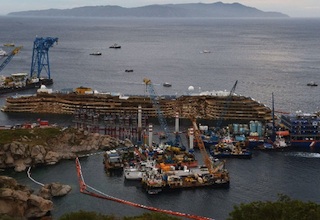
If you’re anything like me, you followed one of this week’s news obsessions that, unlike a typical week, involved an amazing engineering feat. I’m talking of course about the Costa Concordia cruise ship salvage operation at Isola del Giglio off the western coast of Italy. On Monday, crews began the work of righting the ship in the water in order to eventually tow it to a port where it will be cut up for scrap. Less than 24 hours later, the ship was righted and resting on an underwater platform specifically built to stabilize the giant ship.
In terms of sheer engineering effort, project planning took well over a year with the entire project projected to cost upwards of $800 million.
From an engineering standpoint, the process of righting the ship itself is fairly straightforward to understand. The process, known as parbuckling, is the righting of a sunken vessel by applying leverage in order to rotate it back to an upright position. In principle, it’s nothing more than the application of the principle of mechanical advantage.
However, from a practical perspective, raising a 1,000-foot ship and setting it to rest on an underwater platform almost 100 feet beneath the surface of the sea is anything but routine. And that’s what makes the story so compelling.
Here are a few links of interest with more information about the operation. This link takes you to a slide show depicting the wreck and the plans for the salvage operation.
The Atlantic put together a collection of photos of the Costa Concordia accident and the subsequent recovery.
And here’s a link to a “60 Minutes” piece describing the details of the salvage operation.







Leave a Reply
You must be logged in to post a comment.